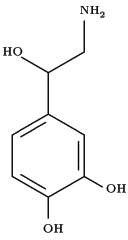Norepinephrine
Norepinephrine (INN) or noradrenaline (BAN) is a catecholamine and a phenethylamine with chemical formula C8H11NO3. It is released from the adrenal glands as a hormone into the blood, but it is also a neurotransmitter in the nervous system where it is released from noradrenergic neurons during synaptic transmission. As a stress hormone, it affects parts of the human brain where attention and impulsivity are controlled. more...
Along with epinephrine, this compound effects the fight-or-flight response, activating the sympathetic nervous system to directly increase heart rate, release energy from fat, and increase muscle readiness.
The host of physiological changes activated by a stressful event are unleashed in part by activation of a nucleus in the brain stem called the locus ceruleus. This nucleus is the origin of most norepinephrine pathways in the brain. Neurons using norepinephrine as their neurotransmitter project bilaterally from the locus ceruleus along distinct pathways to the cerebral cortex, limbic system, and the spinal cord, among other projections.
At synapses it acts on both alpha and beta adrenoreceptors.
Antidepressants
Changes in the norepinephrine system are implicated in depression. Serotonin-norepinephrine reuptake inhibitors (SNRIs) treat depression by increasing the amount of serotonin and norepinephrine available to postsynaptic cells in the brain. There is some recent evidence showing that the norepinephrine transporter also normally transports some dopamine as well, implying that SNRIs may also increase dopamine transmission. This is because SNRIs work by preventing the serotonin and norepinephrine transporter from taking their respective neurotransmitters back to their storage vesicles for later use. If the norepinephrine transporter normally recycles some dopamine too, then SNRIs will also enhance dopaminergic transmission. Therefore, the antidepressant effects associated with increasing norepinephrine levels may also be partly or largely due to the concurrent increase in dopamine (particularly in the prefrontal cortex).
Some other antidepressants (for example some tricyclic antidepressants (TCAs)) affect norepinephrine as well, in some cases without affecting other neurotransmitters (at least not directly).
Role in attention
Norepinephrine, along with dopamine, has come to be recognized as playing a large role in attention and focus. In response, Eli Lilly Pharmaceuticals has released Strattera (atomoxetine), a selective norephinephrine reuptake inhibitor, for the treatment of ADHD in adults and children. Strattera is unique in medications specifically indicated for ADHD, as, unlike the psychostimulants (methylphenidate, dextroamphetamine, Adderall (a racemic mixture of amphetamine salts)), it affects norephinephrine, rather than dopamine. As a result, Strattera has a very low abuse potential and can act 24 hours-per-day. (It should be noted that some antidepressants, including SNRIs, have been used off-label for treatment of ADHD.)
Clinical use
Norepinephrine (commonly referred to by the brand name Levophed) is also a powerful medicine used in critically-ill patients as a vasopressor. It is given intravenously and acts on both alpha-1 and beta-1 adrenergic receptors to cause vasoconstriction. Norepinephrine is mainly used to treat patients in septic shock.
Read more at Wikipedia.org



